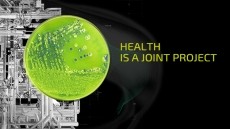Donut-shaped organic molecule mops up chemical waste
both industrial and biological processes, but while it has been
easy to remove positive ions (cations) without disturbing the
surrounding solution, it has been significantly harder to recover
negative ions (anions).
Now scientists have created a ring-shaped organic molecule that strongly binds the anions to a solid support without affecting the solvent or the other solutes. Anions are often important in biological processes, and an incorrect balance of these particles can lead to diseases such as cystic fibrosis. Since the molecule is neutrally charged and insensitive to the pH of a solution, the researchers hope it could be used to regulate these particles in medical applications in addition to mopping up waste in chemical production. "It is not sensitive to pH and therefore might be useful for anion transport through hydrophobic membranes in physiological contexts," Amar Flood of Indiana University, Bloomington, said in an interview. There are currently many organic compounds that can remove cations, but anions have a lower charge density, making it much harder to find suitable substances that provide a strong enough attraction to bind the anion and hold it fast until it is removed from the mixture. The researchers believe they have achieved now this, at least for halide ions. The molecule's success largely relies on its donut shape, with a hole in the centre that provides a snug fit for the ion while the surrounding ring of atoms excludes any of the solvent or other solutes. The ring shape helps to direct the electronic attraction of the molecule into hole at the centre. "When we made the same molecule in a linear format, it bound the chloride anion …. only exceedingly poorly," said Flood. "All our hydrogen bonds focus into the centre like spokes in a carriage wheel, providing the near-ideal 180 degrees geometry for hydrogen bonding." The hydrogen bonds are further strengthened by the chemical composition of the molecule. Flood explained: "Our use of the particular 1,2,3-triazole ring system polarises the traditionally weak CH hydrogen bond. This arises because the other side of the triazole ring system carries two nitrogen atoms each with a couple of unpaired electrons. These electrons form the negative end of a dipole for which the positive end is at the CH, and therefore provides an attractive place for the anions to be located." The team created the particle using "click chemistry" developed by K. Barry Sharpless of the Scripps Research Institute, which allowed the researchers to stitch the molecule together from smaller units. "The reactions could not have been easier," says Flood. Once the organic molecules have captured all the anions, they can be transferred to an organic solution to remove the chemicals from the original solution. However, Flood hopes that one day the substance will be used as a coating to solid polystyrene beads, which could mop up the anions from a solution before being filtered off, cleaned and reused. The researchers also hope to adjust the structure of the substance with new receptors that could attract other types of anions.









